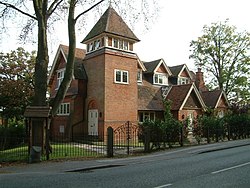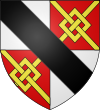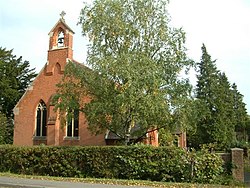Spencers Wood: Difference between revisions
Created page with "{{Infobox town |name=Spencers Wood |county=Berkshire |picture=The_Chapel,_Spencers_Wood._-_geograph.org.uk_-_64413.jpg |picture caption=The Chapel, Spencers Wood |os grid ref=..." |
|||
| Line 48: | Line 48: | ||
==About the village== | ==About the village== | ||
[[File:The_Farrier%27s_Arms,_Spencers_Wood_-_geograph.org.uk_-_64409.jpg|right|thumb|200px|The Farriers Arms]] | [[File:The_Farrier%27s_Arms,_Spencers_Wood_-_geograph.org.uk_-_64409.jpg|right|thumb|200px|The Farriers Arms]] | ||
The local pub is called ''The Farriers' Arms'', although it was briefly called ''The Cygnet'' when it was purchased by the owner of ''The Swan'', a pub in neighbouring [[Three Mile Cross). Before the Swallowfield Bypass was built, it was a popular place for coaches to stop on their way to the south coast. | The local pub is called ''The Farriers' Arms'', although it was briefly called ''The Cygnet'' when it was purchased by the owner of ''The Swan'', a pub in neighbouring [[Three Mile Cross]]). Before the Swallowfield Bypass was built, it was a popular place for coaches to stop on their way to the south coast. | ||
The village post office is on the Basingstoke Road. It has been a post office since 1885, and was a manual telephone exchange until 1934. | The village post office is on the Basingstoke Road. It has been a post office since 1885, and was a manual telephone exchange until 1934. | ||
Latest revision as of 12:23, 24 December 2014
| Spencers Wood | |
| Berkshire | |
|---|---|
 The Chapel, Spencers Wood | |
| Location | |
| Location: | 51°23’40"N, -0°58’20"W |
| Data | |
| Population: | 4,019 (2011) |
| Post town: | Reading |
| Postcode: | RG7 |
| Dialling code: | 0118 |
| Local Government | |
| Council: | Wokingham |
| Parliamentary constituency: |
Wokingham |
Spencers Wood is a village near Shinfield in Berkshire, four miles south of Reading. The village of Three Mile Cross adjoins it to the north and to the west sits the village of Grazeley.
History

The village was named after the le Despencer family, a Norman family, in the 13th century. Until about 1300, the village was part of the Royal Forest (Windsor Forest).
In the 13th century, Spencers Wood was administered by William Longespée, Earl of Salisbury and his court in Amesbury, hence at that time Spencers Wood and its area were considered to belong to Wiltshire, localy situate in Berkshire. Nearby Swallowfield was split between Wiltshire and Berkshire, with Part Lane marking the partition.
In 1860, most of the land, which was hitherto common land, was enclosed and separately acquired by two local gentlemen; the local philanthropist Frederick Allfrey, and William Merry, who was a County magistrate and a visiting magistrate to Reading Gaol, as well as Secretary at War Lord Palmerston's private secretary from 1812 to 1828.

By 1880, Spencers Wood had become a thriving village with a population of 600, of whom 200 were children. Most of the working men worked in the fields or were in domestic service. Victorian and Edwardian style houses were built along the Basingstoke Road using bricks baked at the local Swain family kiln. The Square became the heart of the village during this building period. Many of the houses still stand.
In spite of its growth, Spencers Wood was still split between the ecclesiastical parishes of Shinfield, Swallowfield and Grazeley. This changed in 1908 when the Church of St Michael and All Angels was consecrated. The boundaries were finally officially changed five years later, although some parts of the village were still in the ecclesiastical parish of Grazeley. Also on 1908, the local school was opened, which ended the necessary walk to Swallowfield's Russell Hall, Shinfield or Grazeley School.[1]
Second World War
Spencers Wood was barely affected directly by the War, though one German aeroplane was shot down locally.
The main impact of the War was the influx of people. Two coaches of evacuees arrived in the village in September 1939. Evacuee children and local children were educated separately until Christmas 1939. Canadian forces were stationed in the village for a while, and a small POW camp was opened after the Canadians relocated. Some POWs helped on the local farms. The village hall served as the Local Defence Volunteers headquarters. Basingstoke Road was the main road to Aldershot, and frequent troop convoys ran through the village.
After the war, many soldiers, evacuees and prisoners of war decided to settle in the village, in addition to this, a baby boom helped the population of the village to grow.
Recent history
The first street lighting in the village was installed after the war.
In 1954, Spencers Wood Women's Institutes|Women's Institute was formed. It was quite successful, with 60 members at its height. It closed in the mid-1980s.
In the 1960s, the M4 motorway was built and became a man made barrier between the village and Reading. In the 1980s, the A33 Swallowfield Bypass severed roads to the village of Grazele lying to the east.
Despite local opposition, many new houses have been built in the village in recent years.
About the village

The local pub is called The Farriers' Arms, although it was briefly called The Cygnet when it was purchased by the owner of The Swan, a pub in neighbouring Three Mile Cross). Before the Swallowfield Bypass was built, it was a popular place for coaches to stop on their way to the south coast.
The village post office is on the Basingstoke Road. It has been a post office since 1885, and was a manual telephone exchange until 1934.
The village has two areas with allotments.
Outside links
| ("Wikimedia Commons" has material about Wood Spencers Wood) |
References
- ↑ Spencers Wood Local History Group, Our Village of Spencers Wood
